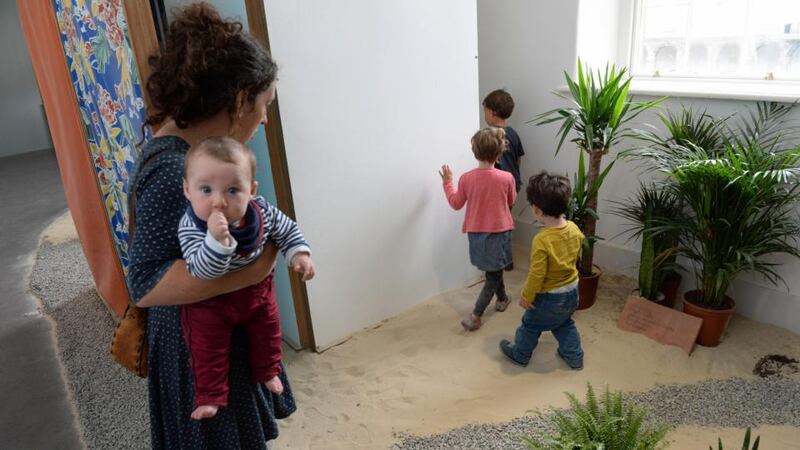Art galleries are my go-to place for rainy day run-arounds with my young children. All those big empty rooms. All those long corridors. I am not going to pretend that my two-year-old has any interest in the work hanging on the walls, but why would he? It sits two feet above his head.
But contemporary art, sculpture and multimedia installations used to pique his interest. I remember following him around the Alice Maher exhibition staged at Earlsfort Terrace last year while Imma’s Royal Hospital premises were being renovated.
The gallery space was paradise for my curious child: light installations beckoned him into the small rooms that lined the long central corridor, and an enormous ice sculpture, like the Snow Queen’s chariot, sat in the middle of it all. But nearly all the pleasure of our visit was spoiled by the vigilance of the invigilator, who followed us around, barking, “Don’t touch! Please keep the children back.”

So it was with some astonishment that I came across the work of Hélio Oiticica this week, at a fabulous retrospective at Imma. I visited the exhibition first alone, on a rare child-free afternoon, and I was so absorbed by the opportunity to read the blurbs uninterrupted that it took me a while to notice that the entire exhibition was a direct invitation to touch and experience the installations.
Not that you would know it. Nearly all the visitors stood back from the art, reading the blurbs impassively. It got me thinking about cultural conditioning and the way we experience art as adults, shuffling along in respectful silence.
I returned a couple of days later with a group of friends and their toddlers, curious about how the children would react to Oiticica’s work – and what the limits of participation were. Would the invigilators intervene if the children started throwing the stones that lined the indoor beach or, worse, started throwing them at the live birds?
Throwing themselves in
The exhibition, called
Propositions
, is a series of proposals and invitations to the audience to act in the context of the gallery space. I cannot imagine a group more willing to throw themselves into the experiential possibilities of art than toddlers.
The retrospective is made up of a variety of geometric pattern paintings, bright architectural mobiles – kites, my toddler called them, although one was a bird – and a series of spectator-driven installations.
The first of these that piqued the children's interests was Penetrable, a wooden cabinet with sliding panels that invoked the familiar game of hide and seek. Although the toddlers couldn't move the panels themselves – indeed, their parents barely could – they understood that the work was designed to disguise and reveal. (We also had fun playing sardines and managed to squeeze three toddlers and two mothers, one heavily pregnant, into a double compartment.)
Entrance to the next section of the exhibition was via what we dubbed the Jellyfish: a wide doorway from which dozens of blue plastic cables hung like tentacles from the ceiling. This was a terrifically sensorial experience. Despite its appearance, the plastic was soft, not hard, and the toddlers swished and swashed and grabbed the cables, playing peekaboo and pretending to be monsters.
My seven-month-old buggy buddy loved this. Apart from the teasing texture on his skin as we passed through, the cables created an attractive dappled light-and-shadow effect. Two adjoining rooms offered the opportunity to parade around in costumes in front of a large mirror, and to view more hanging sculptures, but upside down, from the vantage point of mirrors on the floor.
The main corridor of the exhibition was dominated by Nas Quebradas, a deliberately unstable gravel hill, built on bricks that moved underfoot as you mounted it. As my wily toddler navigated the mound, the invigilators made themselves known for the first time, providing a caution about slipping on the unsteady surface. But they retreated as suddenly as they emerged, leaving us parents to supervise. This precarious structure paved the way for Tropicália, an indoor beach, with a secret beach hut, a sort of large-scale beribboned sensory box, and two live parrots.
Undoubted hit
The undoubted hit with the toddlers was
CC2 Onobject
, a dark room kitted out like a soft-play centre. To a Yoko Ono punk-inspired soundtrack, and against a backdrop of projections invoking Nietzsche and other philosophers, the toddlers moved giant sponge cylinders, squares and triangles around, and generally went a little crazy. We spent about 30 minutes in this room, and during that time not a single other adult entered, although maybe the toddlers were a bit intimidating.
What I found most remarkable was the burst of energy this uninhibited romp gave the toddlers. They left ready to review certain pieces again – the Jellyfish, in particular – and on the way out we looked at many of the “weird sculptures”, as my two-year-old dubbed them, that line the route to the car park.
We had an enormous amount of fun, but I was left wondering how to talk about our experience with my toddler: how to introduce the idea of art into the equation? Over the summer Imma is offering hour-long workshops to families inspired by the exhibition, although they are geared to older participants than our party.
Over dinner that evening we described our day for Daddy. We paid particular attention to texture, colour, sound, and I left it at that, not wanting to kill the spontaneous reactions the work inspired. Fun is probably the best incentive for a toddler to want to return to a gallery, but I doubt we will ever find as exciting an exhibition as Oiticica’s.
Propositions is at Imma until October 9th. There are free family workshops every Wednesday and Thursday, 10-11am, until August 28th. Imma also offer a Babies in Buggies, Parents with Prams tour on Fridays, 10.45-11am, until August 29th












